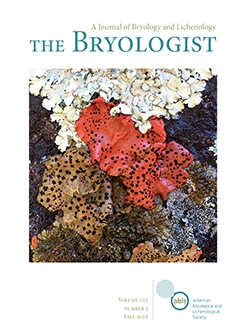Originally described from a single collection in northern California, Umbilicaria phaea var. coccinea has since been reported from additional sites in California, Oregon and Washington. Although relatively rare in all three states, there is currently no conservation status for U. phaea var. coccinea in California. Developing conservation strategies and status ranks requires a sound understanding of distribution, frequency, habitat requirements and taxonomic placement. Therefore, we evaluated distributions and constructed climate envelope models for both varieties of U. phaea. Umbilicaria phaea var. coccinea appears to be restricted to relatively small habitats within the range of U. phaea var. phaea and is only locally common in portions of the Klamath River watershed. To assess evolutionary relationships between the varieties, we evaluated four molecular loci: ITS2, LSU, Mcm7, and mtSSU. A combined phylogeny using maximum-likelihood and Bayesian inference indicated that U. phaea is monophyletic. Within the U. phaea clade, var. coccinea and var. phaea do not form mutually exclusive, monophyletic clades; instead, individuals are intermixed. Based on variation in pigment production, morphology, and geographic distribution, we recommend continued designation of U. phaea var. coccinea as a variety. To better understand the chemical diversity within U. phaea, we compared qualitative differences between secondary metabolite profiles of U. phaea var. phaea and U. phaea var. coccinea acetone extracts using ultraperformance-liquid chromatography high resolution tandem mass spectrometry in negative ion mode. UV spectroscopy, thin-layer chromatography and chemical spot testing were used to further characterize the compounds present. Overall, ten compounds were detected in extracts of U. phaea var. phaea and U. phaea var. coccinea. Five previously known chemical substances were identified in both U. phaea varieties including: orsellinic acid, lecanoric acid, hiascic acid, gyrophoric acid, and orsellinylgyrophorate, along with four unknown metabolites. One additional unknown substance whose chemical properties are consistent with a polyhydroxylated anthraquinone pigment was detected only in U. phaea var. coccinea. Given its rarity, chemical uniqueness, and distinct ecological association, U. phaea var. coccinea warrants a protected status throughout its range.
How to translate text using browser tools
29 June 2022
Umbilicaria phaea var. coccinea: conservation status, variety rank, and secondary chemistry
Jessica L. Allen,
Lalita M. Calabria,
Heather E. Braid,
Eric Peterson,
John Villella,
Steven Sheehy,
Katherine Glew,
Jesse Manuel Graves,
Anna Berim,
Roger D. Bull,
Chandler T. Lymbery,
R. Troy McMullin
ACCESS THE FULL ARTICLE

The Bryologist
Vol. 125 • No. 3
Fall 2022
Vol. 125 • No. 3
Fall 2022
biodiversity
biogeography
climate change
conservation biology
Integrative taxonomy
Pacific Northwest




